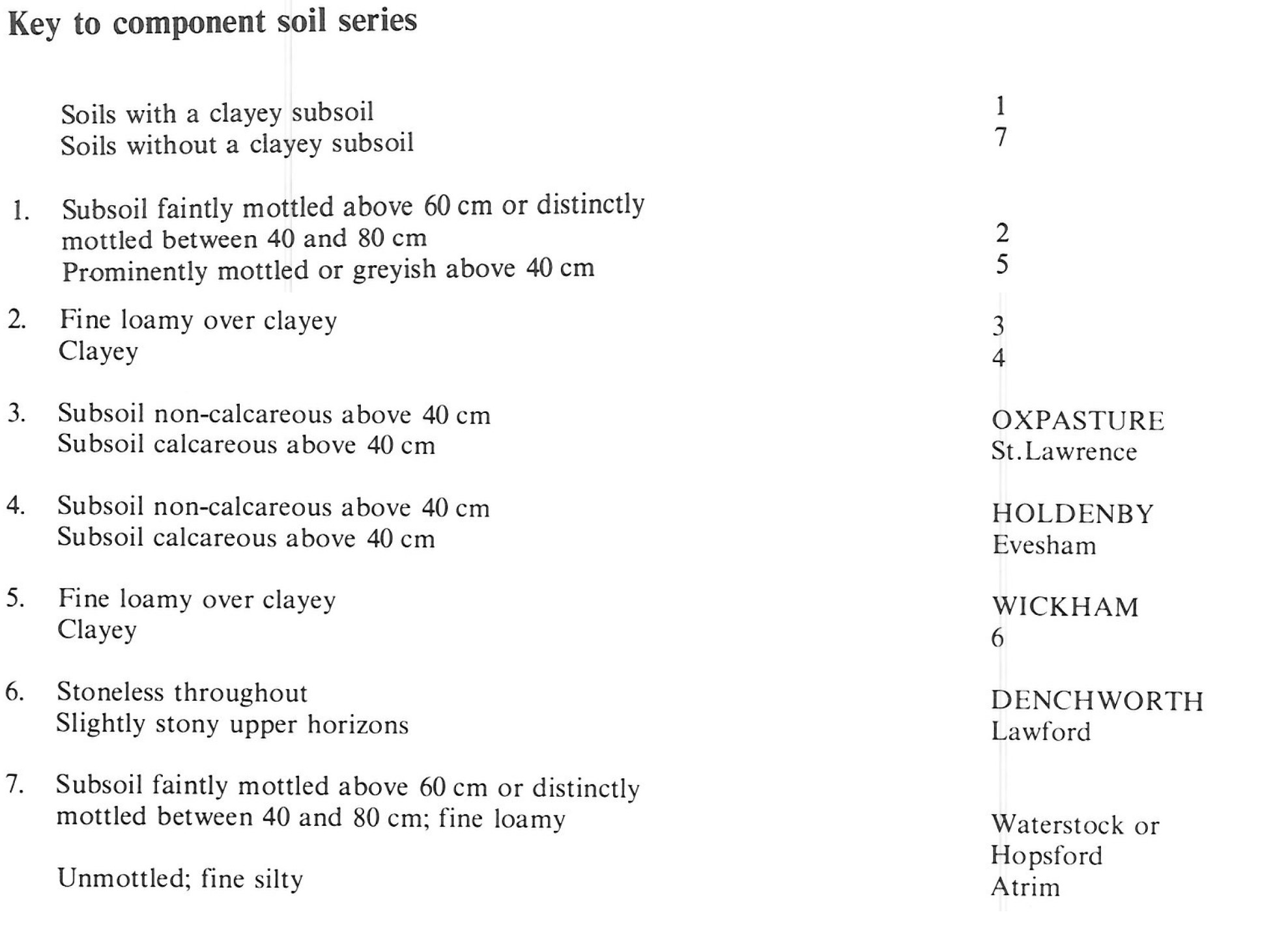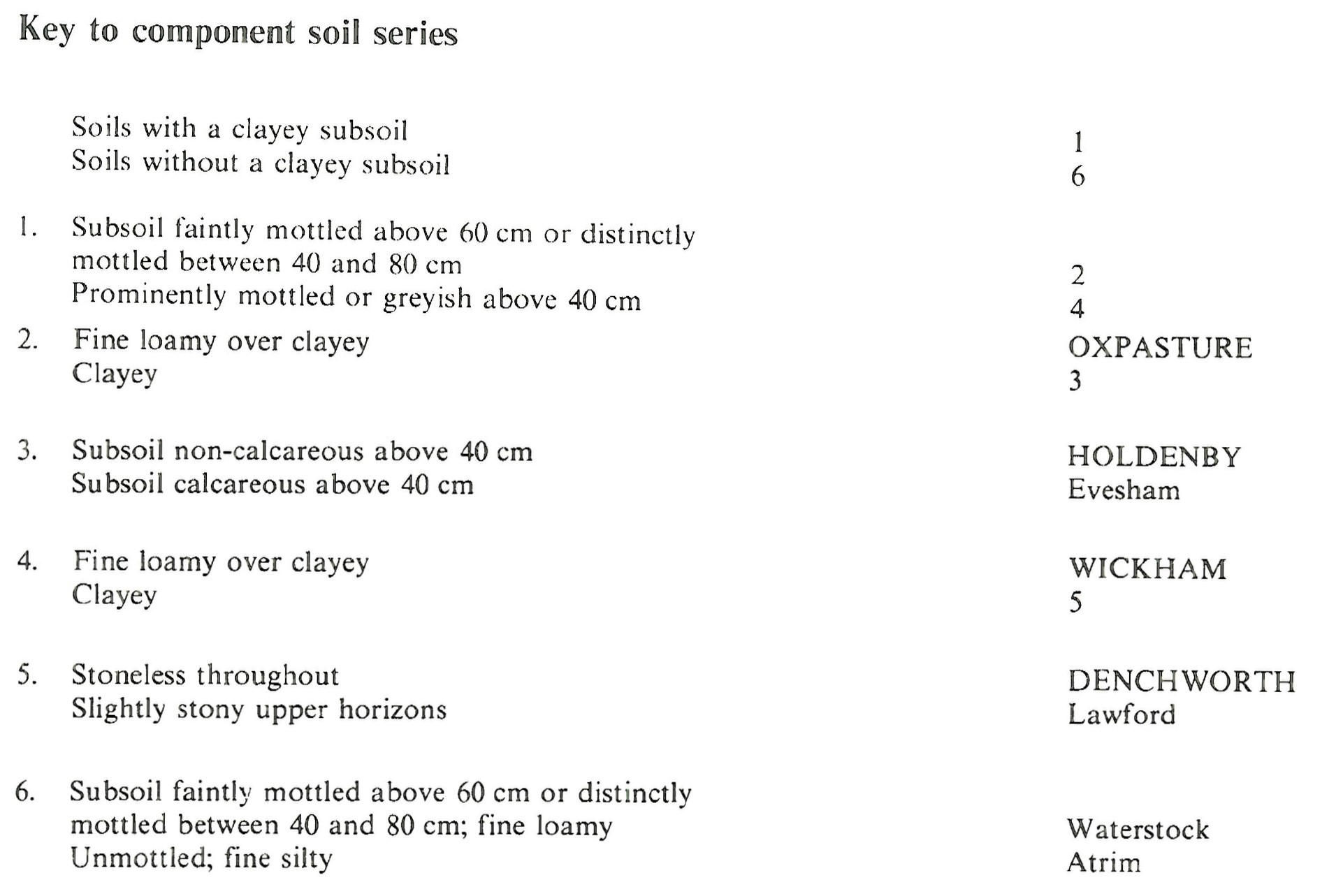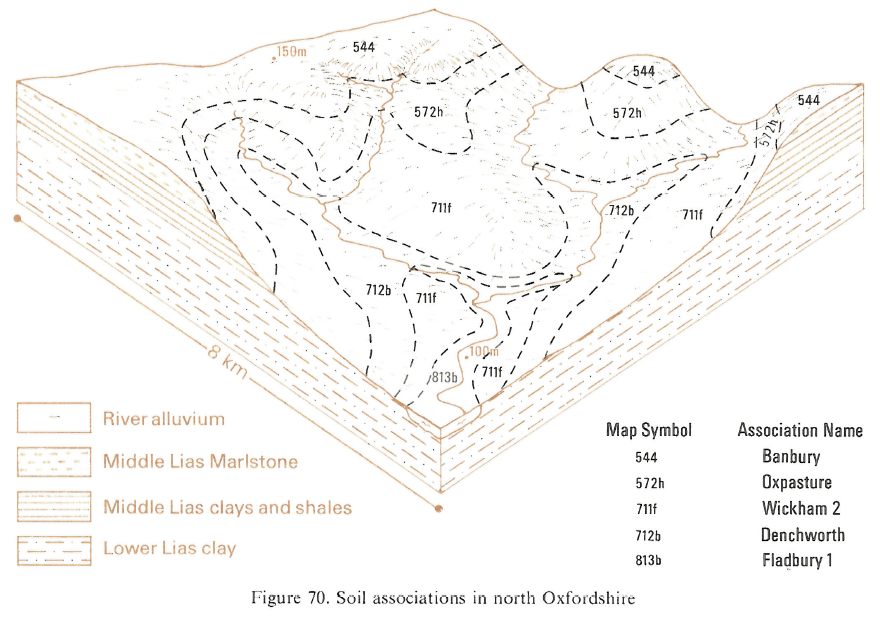
Soil Associations
0572h OXPASTURE
Soil and site characteristics
Fine loamy over clayey and clayey soils with slowly permeable subsoils and slight seasonal waterlogging. Some slowly permeable seasonally waterlogged clayey soils.
Geology
Drift over Jurassic and Cretaceous clay shale
Cropping and Land Use
Winter cereals and short term grassland dairying in moist lowlands of the South West.
Component soil series
| Subgroup | Series name | Percentage | WRB 2006 link |
|---|---|---|---|
| 5.72 | OXPASTURE | 42% | Endostagnic Luvisols |
| 7.11 | WICKHAM | 18% | Eutric Luvic Planosols |
| 4.31 | HOLDENBY | 10% | Vertic Endostagnic Luvisols |
| 7.12 | DENCHWORTH | 10% | Eutric Vertic Stagnosols |
Covers 491 km2 in England and Wales
Soilscapes Classification
| 8 |
Slightly acid loamy and clayey soils with impeded drainage |
0572h OXPASTURE
Detailed Description
This association is mapped where thin fine textured drift covers slowly permeable Jurassic clays, silts and mudstones. The fine loamy over clayey Oxpasture series, stagnogleyic argillic brown earths, predominates and the similar but wetter Wickham series, typical stagnogley soils, is locally extensive. Where the drift is clayey Holdenby soils, typical argillic pelosols, are important. Occasionally the thin drift is absent giving wet stoneless Denchworth series, pelo-stagnogley soils.
The association is widely distributed in the Midlands and southern England on the Jurassic outcrop from Somerset to Leicestershire. The thin drift is mainly Head from nearby higher ground, which is locally capped by till, but on lower ground adjacent to watercourses there is some contribution from river terrace deposits. The association is mapped in Leicestershire mainly around Market Harborough and in Worcestershire and Warwickshire along the foot of the Cotswolds between Broadway and Priors Marston. It occurs mainly on gentle to moderate slopes on Upper, Middle and Lower Lias clays and Middle Lias silts. The composition of the association varies with the nature of the drift and its position in the landscape. In Leicestershire clayey Head gives a large proportion of Lawford and Holdenby soils whilst thin river terrace drift gives mainly Oxpasture and Wickham soils. Locally, in narrow valleys, strips of alluvial, clayey Fladbury soils have been included. Evesham soils are restricted to eroded sites on valley sides where calcareous clays are exposed and patches of Irondown soils on small ironstone outcrops are included in southern Leicestershire. On the Middle Lias silts and clays, profiles of the A trim series are locally important usually on moderately steep slopes where occasional small ironstone fragments are incorporated in the topsoil. Denchworth soils are found on lower ground usually in valley bottoms, where drift is locally absent. In Warwickshire the association mainly borders rivers and streams. Here, the upper horizons of the Oxpasture and Wickham series are in river terrace drift and Fladbury soils are included on thin strips of alluvium. At the foot of the Cotswold scarp near Broadway a small proportion of St Lawrence and Waterstock soils are found in thin drift.
The association is mapped in Northamptonshire between Daventry and Peterborough. It occurs mainly on gentle to moderate slopes on Upper, Middle and Lower Lias clays and Middle Lias silts. The composition of the association varies with the nature of the drift and its position in the landscape, so locally it includes Hopsford, Waterstock, Atrim and St Lawrence soils. Head derived from Plateau Drift and Jurassic rocks gives Lawford and Holdenby soils whilst thin river terrace deposits give mainly Oxpasture and Wickham soils and some Hopsford and Waterstock soils near Wellingborough. Locally in narrow valleys, there are strips of Fladbury soils on alluvium. Evesham soils occur on eroded valley slopes and there are local patches of Irondown soils on small ironstone outcrops. On the Middle Lias, Atrim series is locally extensive on moderately steep slopes and has occasional small ironstone fragments in the topsoil. Denchworth soils are found on lower ground where drift is very thin or locally absent. The proportions of Denchworth and Wickham soils decrease eastward across Northamptonshire as the Evesham soils become more common. In north-east Northamptonshire, between Elton and Thorpe Waterville, Head derived from limestone occurs along rivers and streams giving St Lawrence soils. Papworth soils also occur and are locally common.
In east Somerset and north Dorset the association is found in the Sparkford Vale and Blackmoor Vale along tributaries of the Yeo and Stour. Between Yeovil and Castle Cary it includes much of the drift-covered lowland formerly mapped as Podimore series, and takes in patches of limestone gravels with calcareous Badsey and St Lawrence series. The bottoms of minor valleys have clayey Fladbury and Wyre soils. In the Blackmoor Vale, flinty drift is extensive on ridges crests and valley sides, here Evesham series occurs to a minor extent. There are small scattered occurrences in Wiltshire in the Nadder valley near Tisbury, in Greensand drift, and near Salisbury where the soils are mapped in drift from Tertiary rocks over London Clay.
In Gloucestershire, the soils are found below the Cotswold scarp around Coaley near Stroud and from Winchcombe to Broadway, and again between Chipping Campden and Blockley, where brown fine loamy and fine silty drift overlies thin gravelly layers on Lias clay. In the north the soils are particularly silty and include some Atrim and Curtisden soils. A small area at Norton, north of Gloucester, is in river terrace deposits.
The association is found mainly on gentle and moderate slopes. In north Buckinghamshire between Buckingham, Newport Pagnell and Quainton, and in Oxfordshire between Steeple Aston, Witney and Chipping Norton it occurs on lower valley slopes adjacent to alluvium where the Head is often derived from river terrace deposits, and as narrow strips on valley sides where the Middle Lias clays and shales outcrop. On thin ironstone beds, small patches of Irondown soils may be present and in north-west Oxfordshire some fine silty Atrim soils occur. On the Isle of Wight near Brighstone and between Sandown and Brading, the association is mapped on Cretaceous Wealden beds and Gault Clay. Here, Holdenby soils are absent and some Kings Newton and Mailing soils are found on thin sandstones. The Gault Clay is covered by thin loamy Head on slopes and there is thick Head in valleys cutting into the Upper Greensand scarp. Oxpasture and Wickham soils occur on the slopes, and small patches of Waterstock and Shabbington soils on river terrace drift add complexity to the soil pattern.
Soil Water Regime
Oxpasture and Holdenby soils have slowly permeable subsoils and even after appropriate drainage are seasonally waterlogged (Wetness Class III). Wickham and Denchworth soils also have slowly permeable subsoils and are waterlogged for long periods in winter (Wetness Class IV). After suitable drainage treatment the regime is improved (Wetness Class III) in drier districts. Because of the moderate permeability of the topsoils and the slowly permeable subsoils, disposal of excess rain is mainly by lateral flow at shallow depth.
Cropping and Land Use
With efficient underdrainage and good management, the soils provide moderately good yields of cereals and grass in rotation. Autumn sown crops, mainly wheat, barley and oilseed rape are preferred because there is little opportunity to work the land in spring. Measures to reduce ground pressure, such as the use of cage wheels, are desirable to protect against structural damage. Timing can be made more flexible on Oxpasture and Holdenby soils by direct drilling, but they are only moderately suited to this technique because of surface compaction and ponding if subjected to traffic under wet conditions. Soil water reserves are generally adequate for most crops but the soils are moderately droughty for grass. Most grassland is grown in rotation but permanent grassland occurs particularly on Denchworth and Lawford soils and on low-lying ground difficult to drain effectively. Suitability for grassland is governed by both droughtiness and poaching risk which restricts the grazing period and stocking density. The Oxpasture and Holdenby soils dry out more quickly than the subsidiary Denchworth and Wickham soils, which have slow internal drainage and low bearing strength when wet. Oxpasture soils have only minor limitations to pasture use but Holdenby, Wickham and Denchworth soils are easily damaged by stock and machinery when wet. On these soils damage caused by poaching can be severe. The soils are slightly acid in the surface where unlimed, but pH rises gradually downwards and is often neutral or alkaline within one metre depth. The potassium status is generally good as there are large natural reserves in the parent material so small applications are required only for continuous cereals. Where crops, such as conserved grass, are grown regularly, potassium can be safely omitted from intervening cereal crops or grazed pastures. Regular dressings of phosphorus are required on the wet Wickham and Denchworth soils because they tend to fix added phosphorus in forms not readily available to plants.
0572h OXPASTURE
Distribution Map
 |
Note that the yellow shading represents a buffer to highlight the location of very small areas of the association.
Keys to component soil series
South Western Region
 |
South Eastern Region
 |
Midlands
 |
Eastern Region
 |
Typical Landscapes
South Western Region
 |
Eastern Region
 |
South Eastern Region
 |
South Eastern Region
 |
All information Copyright, Cranfield University © 2025
Citation: To use information from this web resource in your work, please cite this as follows:
Cranfield University 2025. The Soils Guide. Available: www.landis.org.uk. Cranfield University, UK. Last accessed 25/04/2025
